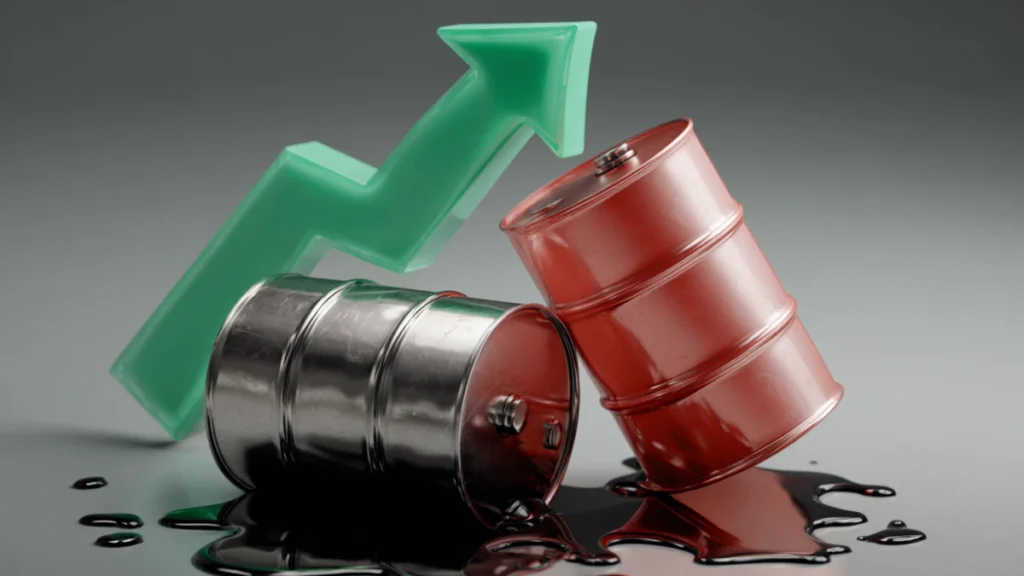Table of Contents
🔍 Introduction: Crude Oil Gears Up for a Volatile Week
Crude Oil is coiling — and traders are watching closely.
After weeks of choppy price action, CL Futures (August contract) and WTI spot are trading near major decision zones. With upcoming U.S. inventory data, renewed OPEC+ headlines, and broader macro risk-on/risk-off sentiment, the first week of July could produce explosive intraday moves.
WTI has been stuck in a range between $80 and $83, while CL futures show clear compression on the 4H chart. But that compression often leads to expansion — and this week might just be the breakout trigger.
In this weekly outlook, we’ll cover:
• 📰 Key news events that could impact Oil prices
• 🗺 Technical zones to watch on CL and WTI
• ⚖️ Bullish vs. bearish scenarios with entry and risk levels
• 🧠 How to trade Oil during low-volume holiday hours
• 🎯 Trading tips for navigating inventory reports and false breakouts
Whether you’re scalping CL intraday or holding a swing position into July, this forecast will help you build a smart, structured trading plan.
🗓️ Crude Oil News Events This Week: OPEC+, Inventories & Macro Risk
This week is event-heavy for the energy markets — and traders need to stay sharp. Here are the key catalysts that could send crude oil prices flying… or crashing.
🛢️ 1. OPEC+ Supply Guidance (Tentative Headlines)
OPEC+ ministers are expected to comment on production targets as oil hovers below recent highs. Traders are watching for:
• Hints at supply cuts/extensions into Q3
• Comments on global demand outlook
• Reaction to U.S. pressure to lower prices
📢 Unexpected hawkish supply cuts = bullish. Talk of tapering cuts or weaker demand = bearish.
🧮 2. EIA Crude Oil Inventory Report – Thursday, July 4 (Delayed)
With U.S. markets closed for Independence Day on Thursday, this week’s EIA data may be released Friday. It remains one of the most impactful events for oil intraday.
Watch for:
• Surprise builds = bearish signal
• Major draws = bullish signal
• Gasoline/distillate inventories — signal demand health
⚠️ Holiday-week volumes can exaggerate price reactions to inventory data
🌍 3. Broader Risk Sentiment (S&P 500, USD, China PMIs)
Oil remains sensitive to macro themes, including:
• USD strength or weakness (affects Oil pricing)
• Global growth sentiment (esp. China & U.S.)
• Equity market trends (risk-on vs. risk-off correlation)
This week’s ISM, JOLTS, and NFP data will shape recession fears or growth optimism — both of which impact crude demand expectations.
✏️ Summary
Event Expected Impact Directional Bias
OPEC+ Commentary High Directional (bullish or bearish)
EIA Inventory Report High Volatility spike
U.S. Jobs Data (NFP) Medium–High Macro trend correlation

📊 Key Technical Levels on CL Futures (GCQ25): Support, Resistance & Structure
Crude Oil (CL Futures – August 2025 contract) is tightening between key resistance and support, forming a classic 4H wedge just below a major breakout level.
Understanding this week’s structure zones is critical — especially ahead of OPEC headlines and Friday’s delayed inventory data.
🔼 Resistance Zones:
• $82.90 – $83.50 → Major supply zone from May/June rejection
o Triple rejection on 4H + potential for breakout traps
o If cleared on volume, opens up $85+ swing targets
• $84.80 → Clean 4H imbalance + daily FVG
o High-probability fade zone for reversals (unless broken clean)
🔽 Support Zones:
• $80.20 – $79.80 → Demand zone formed after last NFP bounce
o Watch for reaction here if price breaks down early week
• $78.60 – $77.90 → Key range low from mid-June
o Strong support if macro sentiment turns bearish
o Below this = clean sell into $75.60 range
🧭 Structure Notes:
• 4H compression with higher lows and lower highs → breakout likely
• Volume profile thinning near $82.50 = breakout magnet
• Expect liquidity sweep before expansion — don’t chase early moves
📈 Trade Setups & Scenarios for Crude Oil: Bullish and Bearish Plans
This week’s Oil setup is all about breakout vs. fakeout. The market is coiling beneath resistance — and with macro catalysts lining up, explosive moves are likely. Here’s how to prepare for both sides:
✅ Bullish Scenario: Breakout Toward $85
Conditions to Enter Long:
• Price breaks above $83.50 with strong volume
• No major bearish divergence on 4H indicators
• Breakout confirmed with New York momentum or post-OPEC headlines
Entry Plan:
• Long above $83.60 on confirmation
• Stop-loss: Below $82.50
• Targets:
o TP1: $84.80 (Daily FVG)
o TP2: $86.00 (Swing high zone)
o TP3: $87.75 (Monthly supply zone)
⚠️ Avoid early breakouts during low volume (e.g., overnight or holiday session). Let volume confirm.
❌ Bearish Scenario: Rejection & Reversal Toward $78
Conditions to Enter Short:
• Price taps into $83.00–$83.50 and fails to hold
• Clear rejection candle (wick + volume flip)
• No bullish catalyst from OPEC or inventories
Entry Plan:
• Short from $83.20 on reversal signal
• Stop-loss: Above $84.00
• Targets:
o TP1: $81.00 (VWAP zone)
o TP2: $79.20 (Key 4H demand)
o TP3: $77.80 (Range low)
🎯 This setup favors patient traders waiting for confirmation. Ideal during NY session or after data release.
🧠 Pro Tip:
Whether long or short — don’t enter before high-impact news drops (like EIA data or OPEC+ press). Wait for the reaction, then follow the flow.
🧠 Trading Oil Like a Pro: Risk, Timing, and Emotional Control
Crude Oil isn’t just another asset — it’s one of the most liquid, manipulated, and news-driven markets on the planet. And trading it without structure can be financial suicide.
If you want to survive (and thrive), it’s not just about your setup. It’s about how you think, how you react, and how you manage risk during fast-moving, emotion-charged environments.
⏰ 1. Know When to Trade — and When to Sit Out
Oil moves best during:
• London Open (7–10 AM GMT) — early positioning, OPEC-related flow
• NYMEX Open (1:00 PM GMT) — U.S. traders dominate, inventory anticipation
• Post-Data Reactions (EIA, NFP, OPEC headlines)
Avoid:
• Thin sessions during U.S. holidays
• Random midday chop without catalysts
• Trading into news events without confirmation
🧠 Pro traders wait for the move — they don’t guess it.
⚖️ 2. Define Your Risk Before You Enter
Set your trade size based on:
• Distance to stop-loss
• Your daily loss limit
• Expected volatility (especially around data)
Never risk more than:
• 1–2% of your capital per trade
• Or $300 daily if you’re working with prop firm rule
🧘 3. Control Your Emotions During Whipsaws
Oil is famous for:
• Stop hunts just before a breakout
• Sharp reversals after fake headlines
• False breakouts on low-volume sessions
What separates amateurs from professionals?
• Pros don’t chase green candles
• Pros don’t move stops impulsively
• Pros do journal and learn from every mistake
📈 Consistency is not about predicting the move — it’s about managing your response to it.
✅ Weekly Checklist for Crude Oil Traders:
• Have I marked key supply/demand zones?
• Did I map both long and short scenarios?
• Am I waiting for volume confirmation before entry?
• Have I defined my SL, target, and daily risk cap?
• Am I trading my plan — or my emotions?

🏁 Final Thought: Be Patient, Be Precise, Be Paid
This week has serious potential — but only for traders with a clear plan, controlled risk, and emotional discipline. Crude Oil is entering a pressure zone that could unlock fast directional moves, sharp rejections, and liquidity sweeps that shake out the weak hands.
Whether you’re scalping CL intraday or swinging based on the 4H structure, your edge lies in preparation, not prediction.
Here’s how to stay ahead while others get whipsawed:
🧭 1. Let the Market Show Its Hand
Don’t anticipate — react to confirmation. Let price break key levels with volume and order flow. Avoid jumping in early because of FOMO or assumptions.
🔑 Clarity > guesswork.
🧠 2. Execute with Precision, Not Impulse
You only need 1–2 quality trades per week to be profitable. Size your trades logically. Place your stops with intention. And don’t abandon your plan mid-trade.
🎯 Discipline pays more than drama.
📓 3. Review Every Trade — Win or Lose
Your journal is your trading mentor. Every missed entry, every rushed decision, every perfect exit — it’s feedback. Track your thought process, not just your P&L.
💡 Data-driven reflection turns emotional traders into professionals.
🔥 BONUS: Know When Not to Trade
Many traders lose more money from overtrading in bad conditions than they do from actual setups. This includes:
• Choppy consolidation before data
• Fake breakouts on holiday sessions
• Emotional revenge trades after a loss
🛑 Sometimes the best trade is no trade at all.
🎯 Bottom Line:
Crude Oil rewards the calm, the strategic, and the unshakeable.
It punishes the impulsive, the emotional, and the unprepared.
So this week — be calm. Be clear. Be the trader who survives, grows, and thrives.
As Crude Oil markets enter a critical week filled with potential breakout triggers, traders should brace for elevated volatility, especially with overlapping events like the delayed EIA inventory report, OPEC+ commentary, and U.S. jobs data. Understanding how oil reacts to macroeconomic pressure is essential — and Investopedia provides an excellent overview of how the EIA report affects crude prices.
Internally, if you’re seeking a tactical guide on how to manage your trades around high-impact events like this, make sure to check out our Killzone Trading Strategy article. This deep dive into session timing and liquidity zones will sharpen your execution. Remember, in news-driven weeks like this, discipline and clarity matter more than prediction. Let the market show its hand — then execute your plan with calculated precision. Whether crude breaks above $83.50 or drops back toward $78, your edge lies in preparation, not emotion.
⚠️ Final Reminder – Disclaimer
This analysis is provided for educational purposes only. It is not financial advice, and nothing in this report constitutes an offer or recommendation to buy or sell any commodity, security, or futures product. Always perform your own analysis and consult a licensed financial professional before making trading decisions. Risk management is your responsibility.

